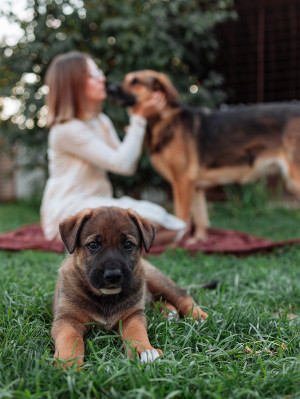Does Your Dog Have a Unique Personality?
Yep, research says your dog is as special and perfect as you tell them they are.

share article

Your pet wants you to read our newsletter. (Then give them a treat.)
Your dog does something every day that pretty much convinces you they’re human. They sigh when they (allegedly) feel the weight of the world on their shoulders. They cry happy tearsopens in a new tab (really!). They get sad opens in a new taband need a day of watching rom-coms and snuggling. Dogs are the same as humans in a lot of ways — including the fact that they also have personalities. So, yes, that means when you tell your pup how special and unique they are, you’re...right. As it turns out, science is exploring character variations in dogs, too. Here’s what the research tells us.
Do Dogs Really Have Unique Personalities?
The name Pavlov probably brings to mind bells and salivating dogs. What you might not know is that early in his studies, Pavlov and his students noticed that dogs differed from one another. Some tended to be nervous and sensitive, some were active and lively, and some were quiet and steady. Pavlov and his team were describing dogs’ personalities.
The concept of personality can be used to convey that individuals differ in how they perceive and interact with the world around them. The word also describes an individual’s usual pattern of behavior — characteristics that are relatively stable over time and across situations. Say there’s a snowman on the front lawn. Some dogs would walk by as though Frosty had always been there. Others might play-bow and dance joyfully in front of their new friend. A few may freeze, tuck, and retreat.
If those same dogs then confront other novel situations — balloons in a tree, a parade, clowns jumping out of a car, you name it — those who perceived Frosty as no bother would probably continue to be indifferent, while those who equated Frosty with Satan would likely be freaked. Although it does not imply that an individual will respond the same exact way every time (dogs are not robots, after all), the term “personality” denotes an individual’s usual perceptions or interactions.
Personality Versus Temperament
Thinking about personality gets tricky very quickly because there is no universal definition. Some fields distinguish between personality and temperament, while others use the terms interchangeably. As Dr. Samuel Gosling, a personality and social psychologist at the University of Texas, Austin, explains, “Temperament is the basic, biologically inherited tendencies of an individual, and personality is the result of the interaction between temperament and the environment.”
That distinction is common in human psychology but is not always made in animal fields. But, as Gosling adds, “Since adult animals are a combination of biologically-inherited tendencies, as well as individual experiences, it seems to me misleading to call that temperament. In humans, we would call that personality, so why not in other animals?”
Why does personality research matter?
Making a distinction between temperament and personality could enable researchers to explore whether certain traits are more stable over time than others. For example, a recent analysis surveying a number of studies found that in puppies, aggressionopens in a new tab and submissiveness were most consistent, while responsiveness to training, sociability, and fearfulnessopens in a new tab were least consistent.
Understanding the relationship between early-life temperaments and later-in-life personalities could be paramount for real-world issues, such as selecting dogs for work or companionship. For working dogs, Gosling and his team advise the U.S. Department of Homeland Security on how to measure personality-trait consistency in order to improve the selection and training of working detector dogs.
Back home, you might think you have a handle on who your puppy is, but what you’re seeing might or might not relate to their future, adult personality. (So even if your pup starts out apprehensive about the vacuum cleaner, there’s hope for improvement.)
At the same time, many shy away from using the term when it comes to non-human animals, sometimes because they’re uneasy about the “A” word: anthropomorphism (giving human characteristics to an animal or object). To avoid linking dogs and personhood so explicitly, scientists use alternative descriptors such as “behavioral types,” “behavioral syndromes,” and “coping styles.” Regardless of the word employed, when the definitions are compared, they tend to describe the same basic phenomenon: consistent, individual differences in behavioral tendencies over time and across situations.
Much of the initial pushback against the term “personality” has dissipated because studies now suggest that personality in non-human animals can be measured and evaluated, just as in humans. (Relatively speaking, this field is in its infancy, and techniques and methodologies continue to evolve, so stay tuned.)
How Is a Dog's Personality Evaluated?
While human personality is often assessed by questionnaires, dogs are less adept with that format, tending to provide insufficient responses (mostly, slobber and paw prints). But their inability to hold a pen does not exclude them from questionnaire-based personality assessments; humans can complete questionnaires on their dog's behalf. The method is reliable because independent observers — in this case, dog parents and other humans who know the dog — generally agree in their descriptions of a dog’s personality. This type of consistency is a hallmark of human personality research and lends credibility to the approach. And, even better, similar ratings provided by observers over time further substantiate the utility of particular questionnaires.
Questionnaires, however, are not bulletproof. Gosling notes that questionnaires “don’t rule out the possibility that ratings are based on some stereotype, say a physical stereotype, like ‘bigger animals are more aggressive.’ You could still get those biases.” Dogs’ physical appearances are emotion points for humans and make them susceptible to attributions and judgments that might have no bearing on the personality of individuals. For example, the Papillon breed standard specifies that these small dogs are to be “happy, alert, and friendly,” and their physical appearance easily promotes this perception of an overall perkiness. But on an individual basis, just like other dogs, Papillons can be shy (or downright neurotic).
Even taking into account the risk of stereotyping, questionnaires provide meaningful information about a dog’s personality. When comparing questionnaire ratings with separate behavior observation assessments, a strong link has been found. So if a dog is judged on a questionnaire to be highly timid, independent observers will generally also describe the dog’s behavior in terms consistent with shyness.
The Canine Behavioral Assessment and Research Questionnaire
Since people are rarely shy about discussing their dogs, collecting data via questionnaires can be incredibly fruitful. The Canine Behavioral Assessment and Research Questionnaireopens in a new tab (C-BARQ), developed by Dr. James Serpell and researchers at the University of Pennsylvania, is a widely used assessment of dog behavioral characteristics (available for public use). The 101 questions gather insights into dogs by asking people to use a five-point scale to describe how their dog would likely react in a variety of different situations, such as anxiety or fear in heavy traffic or when examined by a veterinarian; excited when the doorbell rings or when visitors arriveopens in a new tab; and of course, likely to chase cats if given the opportunity.
A recent study of former breeding dogs from commercial breeding operations — commonly referred to as “puppy mills”opens in a new tab — relied on the C-BARQ to evaluate the dispositions of these dogs once they’re out in the world. Overall, they were found to be more fearful and nervous than typical pet dogs, particularly regarding strangers and stairs, and many were sensitive about being touched. Despite having lived for years in their adoptive households, many of these dogs still displayed persistent fear and anxiety, which is exactly the type of long-term rather than short-term tendencies that investigations of personality aim to reveal.
Observational research
But do we really need questionnaires when a dog’s actual behavior is right in front of us? Of course, it’s easy to watch a dog and write down how they react to various stimuli, but that’s not necessarily enough. While it’s plausible to observe dog behavior in myriad situations by simply waiting for different scenarios — such as flashing lights and loud sirens — to present themselves, test batteries, which are designed to investigate whether various stimuli and situations elicit particular responses, are more common. For example, the Dog Mentality Assessment (DMA) is a behavior test originating in Sweden that requires dogs to respond to, among other things, novel people, furry objects, loud noises, the potential for play, and people dressed up like ghosts (yep, ghosts).
The “Big Five” personality model
The researchers boiled down dogs’ behavioral responses into five personality dimensions: sociability, playfulness, chase-proneness, aggressiveness, and curiosity/fearfulness. Comparing the results from the DMA test battery with the C-BARQ assessment showed broad agreement between the two.
You can think of these personality dimensions as the canine equivalent of the classic human “Big Five” personality models: extroversion (sociable and outgoing), agreeableness (trustworthy and straightforward), neuroticism (anxious, irritable, and shy), openness (curious, imaginative and excitable), and conscientiousness (efficient, thorough, and not lazy). Research groups continue to flesh out the various personality dimensions found in dogs; recently, the Anthrozoology Research Group in Australia generated a slightly different list of attributes, one that included extroversion, neuroticism, motivation, training focus, and amicability.
As you might imagine, it’s not easy to summarize and sort all of a dog’s behaviors into a small number of buckets, so there is much left to learn in this area. One hot topic that warrants more research is the possible relationships between different traits. For example, are individuals who are more bold also more sociable and playful with strangers? Or is it more challenging to find links between traits? While boldness and aggression correlate in some species, researchers have not found that to be true for dogs. Dogs who were bolder were not necessarily more aggressive. The possibilities for this area of research are virtually endless.
What Will My Dog's Personality Be?
At any given moment, chances are that a Beagle’s nose will be pressed to the ground while an Afghan Hound will be striking a pose on the couch. But personality encompasses both genetically-selected attributes, as well as individual life experiences. For that reason, there is no one-to-one relationship between personality characteristics and breedopens in a new tab; personalities can vary within a particular breed based on the experiences of individual dogs.
In fact, in the recent book, Dog Sense: How the New Science of Dog Behavior Can Make You a Better Friend to Your Pet, anthrozoologist John Bradshaw comments that even in Scott and Fuller’s seminal research on dog behavior and genetics, “breed turned out to be less relevant to personality than had been expected at the outset.” The bottom line is that breed characteristics are certainly relevant to who a dog is, but they are not the be-all and end-all when it comes to personality.
The short answer to “What will my dog’s personality be?” is “Wait and see.” Current research finds that puppy tests have low predictive value for later-in-life behavior. On the other hand, personalities examined in older dogs do display more stability over time. Krista Macpherson, a PhD candidate at the University of Western Ontario who studies cognitive abilities in domestic dogs, reminds us that at the time of testing, puppies have had minimal interaction with the outside world, apart from their conspecifics. “At eight weeks, they are not that developed cognitively, and there are a lot of experiences yet to be had,” she observes.
Researchers at the Clever Dog Lab (part of Austria’s University of Vienna) are currently investigating whether early temperament tests are predictive of behavioral tendencies in an older dog. By testing dogs at a range of ages, they will be able to explore the predictive value of early-life temperament tests. At the end of the day, Jules Winnfield, the gangster from Pulp Fiction, gets it right: “A dog’s got personality, and personality goes a long way.”

Julie Hecht, MSc
Julie Hecht, MSc, is a PhD candidate studying animal behavior at the Graduate Center, CUNY, and author of the Dog Spies blog at Scientific American. She would really like to meet your dog.
Related articles
![a brown puppy and a dog of different ages sit with person on grass]() opens in a new tab
opens in a new tabYour Dog’s Personality Can Change Over Time
You won’t live with a rambunctious goofy teenager forever.
![A black dog holding its paw up to a woman's hand.]() opens in a new tab
opens in a new tab15 Amazing Facts About Dogs You Might Not Know
Boost your dog smarts with these cool facts.
![Two dogs playfully standing next to each other outside.]() opens in a new tab
opens in a new tab“Why Don’t My Dogs Get Along Anymore?”
Why relationships change in multi-dog households.
![Blind man with walking stick walks with Golden Retriever guide dog]() opens in a new tab
opens in a new tabAre There Differences Between Guide Dog Breeds?
From puppy to partner, guide dogs are a special breed.






